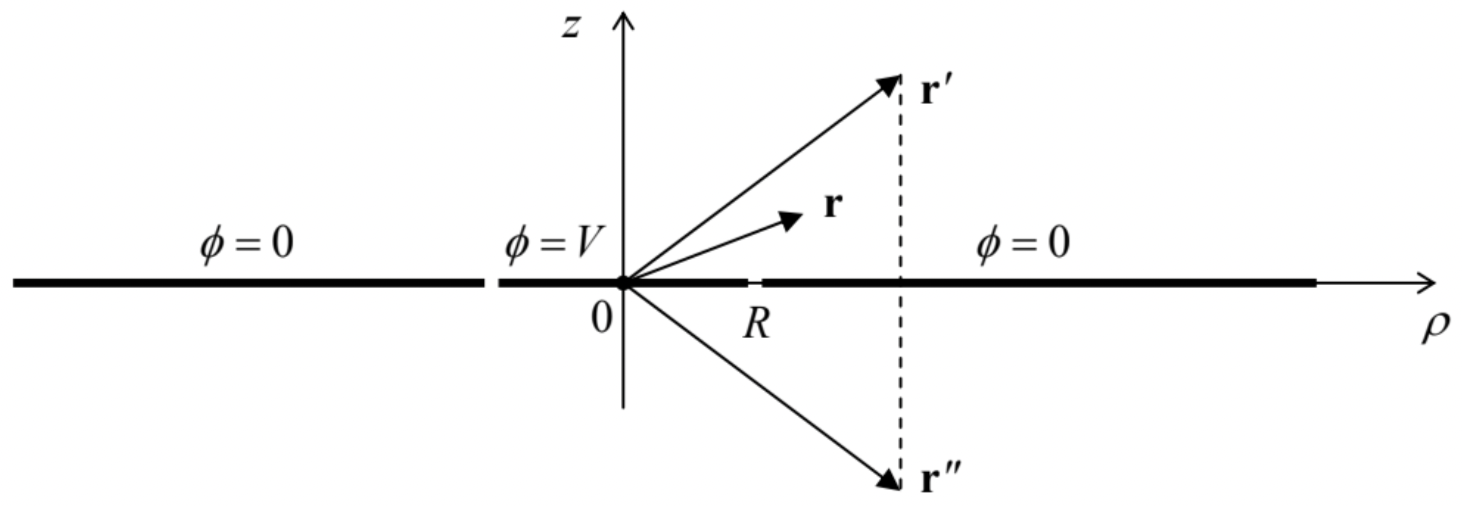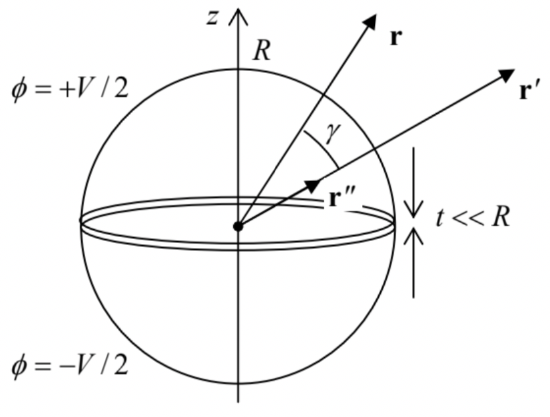2.1: Green’s Functions
( \newcommand{\kernel}{\mathrm{null}\,}\)
I have spent so much time/space discussing the potential distributions created by a single point charge in various conductor geometries because for any of the geometries, the generalization of these results to the arbitrary distribution ρ(r) of free charges is straightforward. Namely, if a single charge q, located at some point r′, creates the electrostatic potential
ϕ(r)=14πε0qG(r,r′),
then, due to the linear superposition principle, an arbitrary charge distribution (either discrete or continuous) creates the potential
Spatial Green’s function
ϕ(r)=14πε0∑jqjG(r,rj)=14πε0∫ρ(r′)G(r,r′)d3r′.
The function G(r,r′) is called the (spatial) Green’s function – the notion very fruitful and hence popular in all fields of physics.65 Evidently, as Eq. (1.35) shows, in the unlimited free space
G(r,r′)=1|r−r′|,
i.e. the Green’s function depends only on one scalar argument – the distance between the field-observation point r and the field-source (charge) point r′. However, as soon as there are conductors around, the situation changes. In this course, I will only discuss the Green’s functions that vanish as soon as the radius-vector r points to the surface (S) of any conductor:66
G(r,r′)|r∈S=0.
With this definition, it is straightforward to deduce the Green’s functions for the solutions of the last section’s problems in which conductors were grounded (ϕ=0). For example, for a semi-space z≥0 limited by a conducting plane z=0 (Fig. 26), Eq. (185) yields
G=1|r−r′|−1|r−r′′|, with ρ′′=ρ′ and z′′=−z′.
We see that in the presence of conductors (and, as we will see later, any other polarizable media), the Green’s function may depend not only on the difference r−r′, but on each of these two arguments in a specific way.
So far, this looks just like re-naming our old results. The really non-trivial result of this formalism for electrostatics is that, somewhat counter-intuitively, the knowledge of the Green’s function for a system with grounded conductors (Fig. 30a) enables the calculation of the field created by voltage- biased conductors (Fig. 30b), with the same geometry. To show this, let us use the so-called Green’s theorem of the vector calculus.67 The theorem states that for any two scalar, differentiable functions f(r) and g(r), and any volume V,
∫V(f∇2g−g∇2f)d3r=∮S(f∇g−g∇f)nd2r,
where S is the surface limiting the volume. Applying the theorem to the electrostatic potential ϕ(r) and the Green’s function G (also considered as a function of r), let us use the Poisson equation (1.41) to replace ∇2ϕ with (−ρ/ε0), and notice that G, considered as a function of r, obeys the Poisson equation with the δ-functional source:
∇2G(r,r′)=−4πδ(r−r′).
(Indeed, according to its definition (202), this function may be formally considered as the field of a point charge q=4πε0.) Now swapping the notation of the radius-vectors, r↔r′, and using the Green’s function symmetry, G(r,r′)=G(r′,r),68 we get
−4πϕ(r)−∫V(−ρ(r′)ε0)G(r,r′)d3r′=∮S[ϕ(r′)∂G(r,r′)∂n′−G(r,r′)∂ϕ(r′)∂n′]d2r′.
 Fig. 2.30. Green’s function method allows the solution of a simpler boundary problem (a) to be used to find the solution of a more complex problem (b), for the same conductor geometry.
Fig. 2.30. Green’s function method allows the solution of a simpler boundary problem (a) to be used to find the solution of a more complex problem (b), for the same conductor geometry.Let us apply this relation to the volume V of free space between the conductors, and the boundary S drawn immediately outside of their surfaces. In this case, by its definition, Green’s function G(r,r′) vanishes at the conductor surface (r∈S) – see Eq. (205). Now changing the sign of ∂n′ (so that it would be the outer normal for conductors, rather than free space volume V), dividing all terms by 4π, and partitioning the total surface S into the parts (numbered by index j) corresponding to different conductors (possibly, kept at different potentials ϕk), we finally arrive at the famous result:69
Potential via Green’s function
ϕ(r)=14πε0∫Vρ(r′)G(r,r′)d3r′+14π∑kϕk∮Sk∂G(r,r′)∂n′d2r′.
While the first term on the right-hand side of this relation is a direct and evident expression of the superposition principle, given by Eq. (203), the second term is highly non trivial: it describes the effect of conductors with non-zero potentials ϕk (Fig. 30b), using the Green’s function calculated for the
similar system with grounded conductors, i.e. with all ϕk=0 (Fig. 30a). Let me emphasize that since our volume V excludes conductors, the first term on the right-hand side of Eq. (210) includes only the stand-alone charges in the system (in Fig. 30, marked q1, q2, etc.), but not the surface charges of the conductors – which are taken into account, implicitly, by the second term.
In order to illustrate what a powerful tool Eq. (210) is, let us use to calculate the electrostatic field in two systems. In the first of them, a plane, circular, conducting disk, separated with a very thin cut from the remaining conducting plane, is biased with potential ϕ=V, while the rest of the plane is grounded – see Fig. 31.
 Fig. 2.31. A voltage-biased conducting disk separated from the rest of a conducting plane.
Fig. 2.31. A voltage-biased conducting disk separated from the rest of a conducting plane.If the width of the gap between the disk and the rest of the plane is negligible, we may apply Eq. (210) without stand-alone charges, ρ(r′)=0, and the Green’s function for the uncut plane – see Eq. (206).70 In the cylindrical coordinates, with the origin at the disk’s center (Fig. 31), the function is
G(r,r′)=1[ρ2+ρ′2−2ρρ′cos(φ−φ′)+(z−z′)2]1/2−1[ρ2+ρ′2−2ρρ′cos(φ−φ′)+(z+z′)2]1/2.
(The sum of the first three terms under each square root in Eq. (211) is just the squared distance between the horizontal projections ρ and ρ′ of the vectors r and r′ (or r′′) correspondingly, while the last terms are the squares of their vertical displacements.)
Now we can readily calculate the derivative participating in Eq. (210), for z≥0:
∂G∂n′|s=∂G∂z′|z′=+0=2z(ρ2+ρ′2−2ρρ′cos(φ−φ′)+z2)3/2.
Due to the axial symmetry of the system, we may take φ for zero. With this, Eqs. (210) and (212) yield
ϕ=V4π∮S∂G(r,r′)∂n′d2r′=Vz2π∫2π0dφ′∫R0ρ′dρ′(ρ2+ρ′2−2ρρ′cosφ′+z2)3/2.
This integral is not overly pleasing, but may be readily worked out at least for points on the symmetry axis (ρ=0,z≥0):71
ϕ=Vz∫R0ρ′dρ′(ρ′2+z2)3/2=V2∫R2/z20dξ(ξ+1)3/2=V[1−z(R2+z2)1/2]
This result shows that if z→0, the potential tends to V (as it should), while at z≫R,
ϕ→VR22z2.
Now let us use the same Eq. (210) to solve the (in :-)famous problem of the cut sphere (Fig. 32). Again, if the gap between the two conducting semi-spheres is very thin (t<<R), we may use Green’s function for the grounded (and uncut) sphere. For a particular case r′=dnz, this function is given by
Eqs. (197)-(198); generalizing the former relation for an arbitrary direction of vector r′, we get
G=1[r2+r′2−2rr′cosγ]1/2−R/r′[r2+(R2/r′)2−2r(R2/r′)cosγ]1/2, for r,r′≥R,
where γ is the angle between the vectors r and r′, and hence r′′ – see Fig. 32.
 Fig. 2.32. A system of two separated, oppositely biased semi-spheres.
Fig. 2.32. A system of two separated, oppositely biased semi-spheres.Now, calculating the Green’s function’s derivative,
∂G∂r′|r′=R+0=−(r2−R2)R[r2+R2−2Rrcosγ]3/2,
and plugging it into Eq. (210), we see that the integration is again easy only for the field on the symmetry axis ( r=znz,γ=θ), giving:
ϕ=V2[1−z2−R2z(z2+R2)1/2].
For z→R, this relation yields ϕ→V/2 (just checking :-), while for z/R→∞,
ϕ→3R24z2V.
As will be discussed in the next chapter, such a field is typical for an electric dipole.
Reference
65 See, e.g., CM Sec. 5.1, QM Secs. 2.2 and 7.4, and SM Sec. 5.5.
66 G so defined is sometimes called the Dirichlet function.
67 See, e.g., MA Eq. (12.3). Actually, this theorem is a ready corollary of the better-known divergence ("Gauss") theorem, MA Eq. (12.2).
68 This symmetry, evident for the particular cases (204) and (206), may be readily proved for the general case by applying Eq. (207) to functions f(r)≡G(r,r′) and g(r)≡G(r,r′′). With this substitution, the left-hand side of that equality becomes equal to −4π[G(r′′,r′)−G(r′,r′′)], while the right-hand side is zero, due to Eq. (205).
69 In some textbooks, the sign before the surface integral is negative, because their authors use the outer normal to the free-space region V rather than that occupied by conductors – as I do.
70 Indeed, if all parts of the cut plane are grounded, a narrow cut does not change the field distribution, and hence the Green’s function, significantly.
71 There is no need to repeat the calculation for z≤0: from the symmetry of the problem, ϕ(−z)=ϕ(z).


